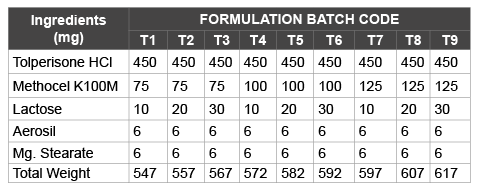
Table 1: Composition of Tolperisone HCl Sustained Release Layer 1

Sahilhusen I Jethara1,2* Mukesh R Patel2
1Research scholar, Gujarat Technological University, Gujarat, India*Corresponding author: Mr. Sahilhusen I. Jethara, Department of Pharmaceutics, Shri B. M. Shah College of Pharmaceutical Education and Research, College Campus, Modasa -383315, Gujarat, India, Tel: +918460378336; E-mail: sahil.pharm4@gmail.com
The aim of this study was to prepare sustained release bilayer tablet of Tolperisone HCl (TOL) and Diclofenac sodium (DFS) for the effective treatment of patient with acute musculoskeletal spasm or acute low back pain. TOL and DFS were formulated as both sustained release layer by using Methocel K100M. A hydrophilic matrix-based bilayer tablet using different contents of Methocel was developed using wet granulation technique to contain 450 mg of TOL and 100 mg of DFS. The effect of contents of hydrophilic matrix (Methocel) and channel forming agent (Lactose) on TOL release was studied. The dissolution study of sustained release layer showed that an increasing amount of Methocel results in reduced TOL release. The dissolution study of sustained release layer showed that an increasing amount of lactose results in increase TOL release. The inclusion of channel forming agent (Lactose) enhanced the release of TOL from sustained release layer. Thus sustained release bilayer tablets could be a potential dosage form for delivering TOL and DFS in a controlled release manner. Formulation containing 25 mg of Methocel K100 M (DFS) and 125 mg of Methocel K100 M (TOL) in both sustained release layer showed desired drug release. Bilayer tablet was suitable for preventing direct contact of these two drugs and thus to maximize the efficacy of combination of two drugs for patient with acute musculoskeletal spasm or acute low back pain.
Tolperisone HCl; Diclofenac sodium; Sustained release; Bilayer tablets; Methocel; Wet granulation
Tolperisone HCl (TOL) is a centrally acting muscle relaxant which is used in the treatment of different pathological conditions like acute and chronic muscle spasm, electroconvulsive therapy, neurological conditions and orthopedic manipulation, myelopathy, encephalomyelitis, spondylosis, spondylarthrosis, cervical and lumbar syndrome, arthrosis of the large joints obliterating artherosclerosis of the extremity vessels, diabetical angthromboangitis obliterans, raynauds syndrome. It is recently launched drug in India for acute and chronic back pain and spasticity of neurological origin. Tolperisone hydrochloride is a “Class-I” drug according to Biopharmaceutics Classification System (BCS), possessing both high solubility and high permeability absorption characteristics. Tolperisone hydrochloride is rapidly and completely absorbed from the gastrointestinal tract. Peak plasma concentrations are reached 0.9-1.0 hours after oral dosing and its elimination half-life ranges from 1.5 to 2.5 hr. TOL is official in Japanese pharmacopoeia [1,2].
DFS, or 2-[(2, 6-dichlorophenyl) amino] benzene acetic acid monosodium salt, is a NSAID having potent anti-inflammatory, analgesic, and antipyretic effects. It is an inhibitor of prostaglandin synthetase. It has an unpleasant taste and causes gastric irritation. DFS is mainly absorbed from the gastrointestinal tract. Chemically, DS is a phenyl acetic acid derivative with a pKa value of 4.0; it is practically insoluble in acidic solution but dissolves in intestinal fluid and water. The maximum average concentration in blood is between 0.7 and 1.5 mg L-1 after a dose is taken. The oral bioavailability is around 60% with an excretion half life between 2.0 h. Thus, sustained release formulations are preferable to avoid frequent administration. DFS is usually prescribed as once-a-day controlled release tablets for management of painful arthritis conditions to reduce the inflammation and thereby reduce pain. Diclofenac sodium is official in Japanese Pharmacopoeia, British Pharmacopoeia, United States Pharmacopoeia and Indian Pharmacopoeia [3,4].
An effort was made to develop simple and effective controlled release TOL and DFS bilayer tablets using a polymer matrix system with uniform in vitro release properties. Methocel is the most commonly and successfully used hydrophilic retarding agent for the preparation of oral controlled drug delivery systems. The transport phenomena involved in the drug release from hydrophilic matrices are complex because the microstructure and macrostructure of Methocel exposed to water is strongly time dependent. Upon contact with the gastrointestinal fluid, Methocel swells, gels, and finally dissolves slowly. The gel becomes a viscous layer acting as a protective barrier to both the influx of water and the efflux of the drug in solution.
The objective of this study was to prepare sustained release bilayer tablet of Tolperisone HCl and Diclofenac sodium for the effective treatment of patient with acute musculoskeletal spasm or acute low back pain, in an attempt to improve bioavailability and to get maximum therapeutic benefits and applicable for long term therapy with better patient compliance about the treatment [5,6].
Tolperisone HCl and Diclofenac sodium were generously provided as gift sample from Themis Medicare Ltd. Vapi, India. Methocel (Methocel K4 M, Methocel K15 M and Methocel K100 M Premium grade) was obtained from Colorcon Asia Pvt. Ltd., Goa, India. Lactose was received as a gift sample from Finar Chemicals Ltd., Ahmedabad, India. Magnesium stearate and Aerosil were obtained from Acme Chemicals Ltd., Mumbai, India. All other chemicals/reagents used were of analytical grade.
Different tablet formulations were prepared by wet granulation technique (Table 1). All the powders were passed through a sieve of 80 mesh size. Required quantities of Tolperisone HCl, different viscosity grades Methocel and lactose were mixed thoroughly and a sufficient volume of granulating agent distilled water was added slowly. After enough cohesiveness was obtained, the mass was sieved through sieve #20. The wet mass was passed through sieve #20 and granular material was dried in oven for 1.0 hr at 40-45°C. Once dry, the granules retained on sieve #40 were mixed with 10% of fines (granules that passed through sieve #40). Aerosil and magnesium stearate were finally added as glidant and lubricant respectively. Prior to the compression, the granules were evaluated for several tests.
Different tablet formulations were prepared by wet granulation technique (Table 2). All the powders were passed through a sieve of 80 mesh size. Required quantities of Diclofenac Sodium, Methocel K100M and lactose were mixed thoroughly and a sufficient volume of granulating agent distilled water was added slowly. After enough cohesiveness was obtained, the mass was sieved through sieve #20. The wet mass was passed through sieve #20 and granular material was dried in oven for 1.0 hr at 40- 45°C. Once dry, the granules retained on sieve #40 were mixed with 10% of fines (granules that passed through sieve #40). Aerosil and magnesium stearate were finally added as glidant and lubricant respectively. Prior to the compression, the granules were evaluated for several tests.
The formulation “D” retains integrity and considered as optimized level of Sustained Release layer of Diclofenac Sodium for the development of bilayer tablet.
Granules of Tolperisone HCl blend were first introduced into the die cavity, a slight compression was made and then Diclofenac Sodium blend was introduced into the die cavity followed by final compressed on 10 station rotary tablet machine using caplet punches (18 cm × 9 cm) with optimum hardness to form the bi layer tablets. The tablets were compressed to obtain hardness in a range of 6-7 Kg/cm2 . Bilayer tablets were prepared & evaluated for various post compression parameters and in vitro dissolution (Table 3) [ 7].

Table 1: Composition of Tolperisone HCl Sustained Release Layer 1
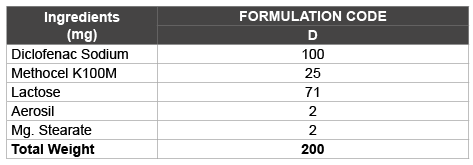
Table 2: Composition of Diclofenac Sodium Sustained Release Layer 2
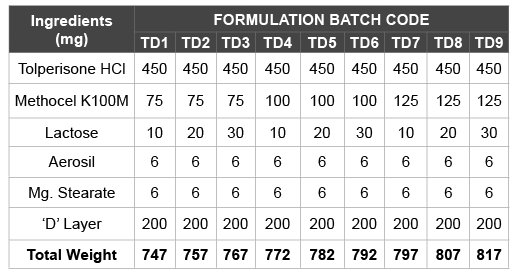
Table 3: Formulation of Bilayer Tablet
Fourier-transformed infrared (FT-IR) spectroscopic studies were performed to check the compatibility between drug and polymer in formulations. The FT-IR spectra of drug alone and with formulation polymers were obtained by KBr (Potassium Bromide) disk method and compared with the standard FT-IR spectrum of the pure drug.
Prior to compression granules were evaluated for the flow properties, such as bulk density, tapped density, carr’s index, Hausner ratio and angle of repose [8,9].
The prepared matrix tablets were evaluated for hardness, weight variation, friability, drug content, in vitro drug release studies. Hardness of the tablets was tested using Rimek-K-DHT 100. Friability of the tablets was tested using Roche friabilator (Electrolab EF-2-USP). The thickness of the tablets was tested using vernier caliper (Mitutoyo CD-6, Japan). Weight variation test was performed according to I.P pharmacopoeia.
The 20 tablets were crushed in mortar and the powder equivalent to 450 mg Tolperisone HCl and 100 mg Diclofenac sodium was transferred to 100 ml of 6.8 pH phosphate buffer in volumetric flask and filter through 0.45 µm Whatman filter paper. After necessary dilution, sample was measured at 276 nm for Diclofenac sodium and 261 nm for Tolperisone HCl using double beam UV-Vis spectrophotometer. The content of drug was calculated from simultaneous equation method [10,11].
The In vitro drug release study for the prepared bilayer tablets were conducted for period of 24 hours using eight-station USP 24 type II (paddle type) Electrolab TDL-08L dissolution test apparatus. The 700 ml of 0.1 N HCl was used as dissolution media for 2 hours followed by 22 hours 6.8 pH by adding 200 ml of 0.2 mol/L tri-basic sodium phosphate in dissolution media. Temperature was maintained constant at 37°C ± 0.5°C. The stirring speed was kept at 50 rpm. 10 ml of sample was withdrawn at specified time intervals, suitably diluted and filtered through whatman filter paper (0.45 µ size). The volume of the dissolution fluid was adjusted by replacing 10 ml of suitable dissolution medium after each sampling. The samples were analyzed by UV spectrophotometer (Shimadzu 1800, Japan) after suitable dilution at specified wavelengths (For 0.1N HCl at 269 nm for Diclofenac sodium and 261.60 nm for Tolperisone HCl, and For 6.8 pH at 276 nm for Diclofenac sodium and 261 nm for Tolperisone HCl). The amount of drug present in each sample was calculated with the help of appropriate simultaneous calibration curve and compared with reference standard [12].
The rate and mechanism of in vitro drug release from prepared bilayer tablets was analyzed by fitting dissolution data into Zero-order (cumulative amount of drug release versus time), First-order (log cumulative percentage of drug remaining versus time), Higuchi (cumulative percentage of release versus square root of time) and Korsmeyer-Peppas (log cumulative percentage of drug released versus log time) equation models [13-15].
Optimized bilayer tablets were stored at 40 ± 2°C and 75% RH in a programmable environmental test chamber (Remi Instruments, Mumbai, India). The bilayer tablets were withdrawn at 1, 2, and 3 month time intervals and evaluated for post-compression parameters like friability, hardness, drug content and in vitro drug release.
The FTIR scan was recorded by using FTIR spectrometer Shimadzu (8400 S) using KBr as negative control (blank). The sample was then analysed at a scanning range 400-4000 cm-1. The interaction study of Tolperisone HCl and Diclofenac sodium with the polymer used was studied using Fourier Transform Infrared spectroscopy method. FTIR spectra of pure drugs and formulation were measured using FT-IR instrument by KBr mixing method. It was found that there were no changes in these main peaks in the FTIR spectra of a mixture of drugs and polymer. Hence, it was concluded that drug had not any interaction with the polymers as revealed from Figure 1 and Tables 4 and 5.
From the values of bulk densities of the formulation indicated good packing character. Bulk and tapped density observed for all formulations (T1-T9, D) was in the range 0.360-0.464g/ml and 0.413-0.528 g/ml respectively. The angle of repose was observed in the range 26°.80΄ to 29°.57΄. Carr’s index was varied in the ranges of 9.70% to 13.33% indicating that the granular blend has good flow property and excellent compressibility for all formulation, and Hausner ratio in the range 1.10 -1.15 (Table 6). Results showed that all parameters were within limits.
The parameters of the bilayer tablets (batches TD1-TD9) such as weight variation, hardness, friability, and drug content were checked and are represented in Table 7. Weight variation of the bilayer tablet was found to be within limits (100 ± 5%). Friability of the bilayer tablet (0.51-0.64%) was found to be less than 1%. Hardness was found to be 6.7 ± 0.12 to 6.9 ± 0.27 kg/cm2, and drug Content of DFS and TOL in the bilayer tablet was found to be 98.25 ± 0.12 to 101.50 ± 0.28 and 98.17 ± 0.24 to 101.11 ± 0.12, respectively.

Table 4: Functional group and frequency of pure Tolperisone HCl

Table 5: Functional group and frequency of Pure Diclofenac sodium
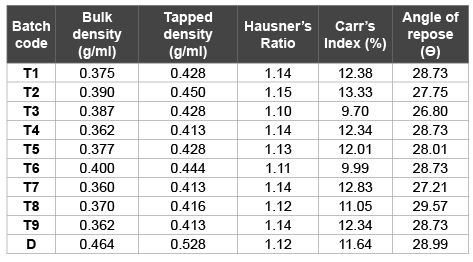
Table 6: Characterization of Granules
The formulations containing the higher content of the polymer shows higher drug release time compare to formulation containing lesser content of polymer. Increase in the content of Lactose increase the channel formation in the tablet shows decrease the dug release time.
To study the effect of polymer content on drug release, nine different formulations for each drug, having different content of Methocel K100 M and channeling agent lactose, were developed. Figure 2 shows the effect of different content of Methocel K100 M and lactose; 75/10, 75/20, 75/30, 100/10, 100/20, 100/30, 125/10, 125/20 and 125/30 (% w/w of Methocel K100 M/lactose) on release rate of Tolperisone HCl. The results of in vitro drug release study are depicted in Table 8 and Figure 2.
All batches exhibits initial burst release of drug due to rapid dissolution of drug from tablet surface. Formulation batch T7 shows 100.27% drug release at the end of 23 hrs. Finally, Dissolution data for optimized Diclofenac sodium layer is given in Table 8 and Figure 2. All the bilayer tablets contains Diclofenac sodium layer were given good release profile. In formulation batches TD1 to TD9, average of Diclofenac sodium layer was given 101.38% drug release at the end of 22 hrs.
To describe the kinetics of drug release from matrix tablets, release data was analyzed according to Korsmeyer et al. [15] equation as
Mt / M∞= Ktn
Where, Mt/M∞ = fraction solute release; t=release time; K=kinetic constant characteristic of the drug/ polymer system; n = exponent that characterizes the mechanism of release of traces.
Based on various mathematical models, the magnitude of the release exponent “n” indicates the release mechanism (i.e. non Fickian diffusion or anomalous transport). In the present study value of n between 0.45 and 0.85 which indicate non fickian diffusion mechanism or anomalous transport. All the formulations revealed Korsmeyer peppas model for the drug release (Table 9).
The 32 factorial design was selected to study the effect of independent variables Methocel100M (X1) and Lactose (X2) on dependent variables t 50 and t90 indicates time required to release 50% of drug and 90% of drug respectively, Q1 , Q12, Q18, Q22, and diffusion exponent (n). The fitted regression equations relating the responses t50 and t90, Q1 , Q12, Q18, Q22 and diffusion exponent (n) are shown in the following equations respectively.
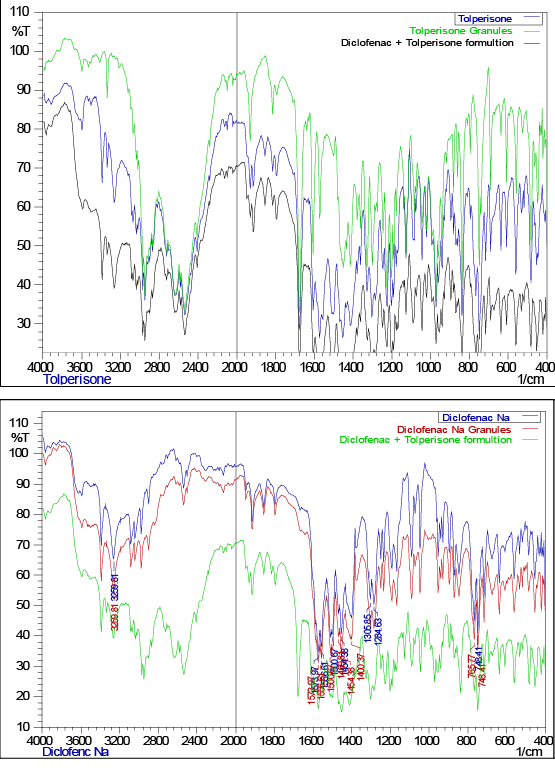
Figure 1: FTIR spectrum of Bilayer Tablet formulation

Table 7: Evaluation of Bilayer Tablet
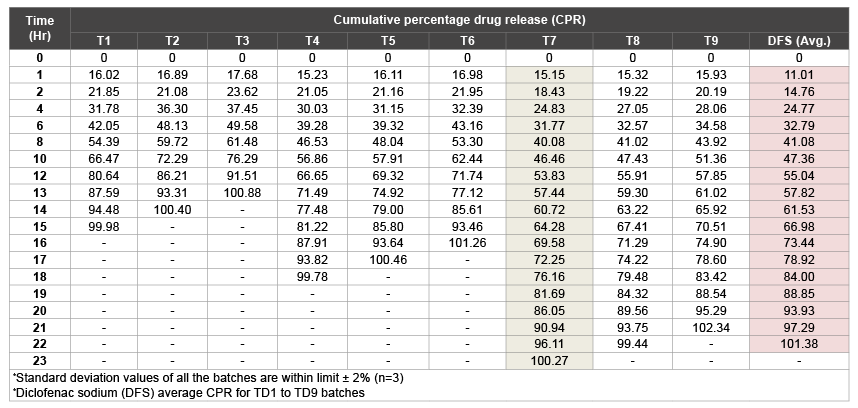
Table 8: Cumulative percentage drug release of bilayer tablets of batches TD1-TD9
t 50 = 7.895+ 1.88 (X1 ) – 0.513 (X2 ) + 0.436 (X1 X1 )- 0.043 (X2 X2 )- 0.010 (X1 X2 )
t 90 = 15.794+ 3.83 (X1 ) – 0.876 (X2 ) + 0.793 (X1 X1 )- 0.086 (2 X2 )- 0.010 (X1 X2 )
Q1 = 16.0677 - 0.698 (X1 )+ 0.698 (X2 ) + 0.058 (X1 X1 )+ 0.058 (2 X2 )- 0.22 (X1 X2 )
Q12 = 69.31 - 15.128 (X1 )+ 3.33 (X2 ) + 1.755 (X1 X1 )- 0.11 (2 X2 )- 1.712 (X1 X2 )
Q18 = 100.41- 10.366 (X1 ) + 1.606 (X2 ) - 10.446 (X1 X1 ) + 0.133 (2 X2 )+ 1.59 (X1 X2 )
Q22 = 100.30 - 0.561 (X1 )+ 1.268 (X2 ) - 0.308 (X1 X1 )- 0.208 (2 X2 ) + 1.332 (X1 X2 )
n = 0.660+ 0.0074 (X1 )- 0.013 (X2 ) - 0.013 (X1 X1 )- 0.0004 (2 X2 )+ 0.009 (X1 X2 )
The t50 and t,90, Q1 , Q12, Q18, Q22 and diffusion exponent (n) response for the nine batches (T1-T9) showed a wide variation in (Table 10). The coefficients of Methocel K100M and Lactose were found to be significant at p<0.05 accept Q22, hence confirmed the significant effect of both the variables on the selected responses.
The response surface plots (Tolperisone HCl layer) were generated using statistica software Version 8.5 to observe the effect of independent variables on the response studied such as t50, t90 Q1 , Q12, Q18, Q22, and n, respectively. The response surface plots revealed that various combinations of independent variables Methocel K100 M (X1 ) and Lactose (X2 ) may satisfy any specific requirement while taking into consideration of various factors involved in dosage form (Figures 3 to 9).
The optimized formulation (TD7) was selected, packed in aluminium foil and subjected to stability studies as per ICH guidelines, 40 ± 2°C and 75 ± 5% RH (Humidity control oven). Samples were withdrawn at time intervals of 1, 2 and 3 month.
The samples were evaluated for hardness, friability, assay and in vitro release profile. The results revealed no significant change in the parameters. The studies revealed that TD7 formulation is stable (Table 11).
The results of hardness, friability and drug content of the formulations subjected to stability studies and in vitro drug release depicted in (Table 11). The drug content and in vitro drug release versus time profile showed a no significant difference in % drug content and % drug release after 3 month when compared with initial.
The use of polymeric matrix devices to control the release of variety of therapeutic agents has become increasingly important in development of the sustained release dosage forms. The device may be a swellable, hydrophilic monolithic systems, an erosion controlled monolithic system or a non erodible system. The present investigation endeavoured to develop the once a day Tolperisone HCl and Diclofenac sodium bilayer tablet using the Methocel as matrix forming material and lactose as channel forming agent. The tablets formed by using wet granulation process displayed appreciable retardation in the drug release. The channelling agent was incorporated into the controlled release system to alter porosity and drug release. In the lactose containing bilayer drug release was achieved due to dissolution of lactose and formation of channels in the matrix that allows the dissolution and diffusion of the drug. 32 full factorial design was employed to study the effect of proportion of Methocel K100 M (X1 ) and proportion of channeling agent lactose (X2 ) on independent variable, time required for drug release 50% (t50), time required for drug release 90% (t90), percentage drug release at 1, 12, 18, 22 hours and diffusion exponent (n) showed extensive deviation.

Table 9: Kinetics of Drug Release for Formulation Batches

Table 10: Result of dependent variables
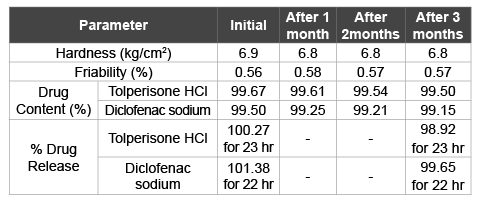
Table 11: Result of bilayer tablets parameter of Accelerated Stability Study
Drug excipient compatibility was studied by FT-IR spectral analysis, the results revealed that there were no interactions between drugs and excipients in this investigation for the development of the bilayer tablet formulation. The drug content was uniform in all the formulation of the bilayer tablets prepared. Pre compression and post compression parameters for all the bilayered tablets formulations were evaluated and the results obtained were satisfactory limits. Methocel K100 M retards the drug release more as compared to Methocel K4 M and Methocel K15 M. The polymer concentration was found to influence the release of drug from the formulation. The result of in vitro drug release profile of bilayer tablets depicts that increase in polymer level, the release rates were found to be decrease. It was found that increases in the content of lactose increase the drug release rate. Fixed optimized batch for all bilayer formulation, Diclofenac sodium was found to be drug release up to 22 hr.
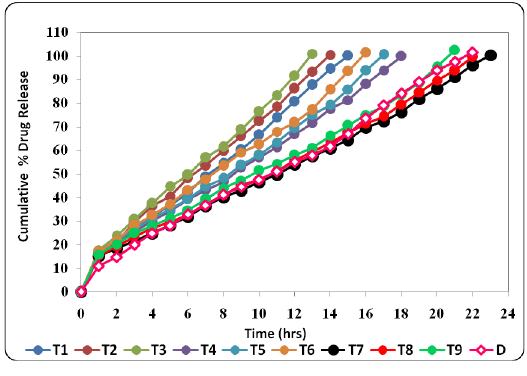
Figure 2: In vitro Drug release studies of Bilayer Tables of TD1-TD9
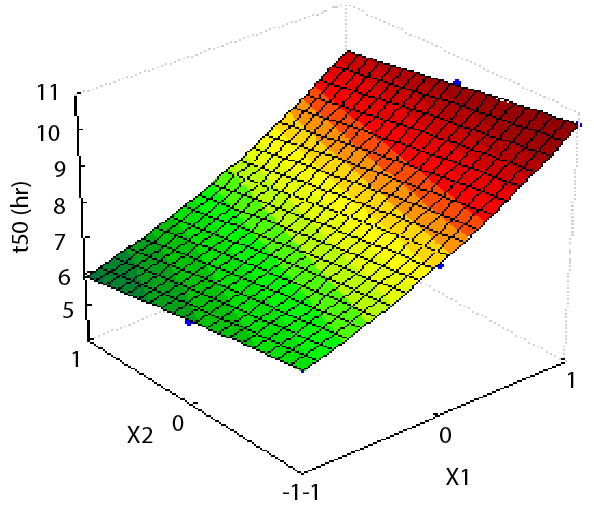
Figure 3: Response surface plot for t50
The content of Methocel K100 M and lactose were successfully optimized by using 32 factorial designs. The bilayer tablets of each batch had desire pre-compression and post-compression characteristics. Amongst all the batches of factorial design, batch T7 (Tolperisone HCl) have more desirable characteristics as the sustained release bilayer tablet demonstrate 100.27% release during 23 hrs release study. The value of diffusion exponent was 0.660 which indicate that the release was anomalous non fickian based and drug release during the first hours of dissolution study was 15.15%. We found that TD7 has best result and good release profile. More ever, the dissolution profile of optimized batch T7 was found to be similar with theoretical drug release profile having similarity factor more than 50 (f 2 =86.74) and dissimilarity factor less than 15 (f 1 =2.08) which reflects the feasibility of the optimization procedure in successful development of sustained release bilayer tablets containing Tolperisone HCl by using Methocel K100M. The bi-layer tablets showed drug release of Tolperisone HCl (upto 23 hr) and Diclofenac sodium (upto 22 h). It was observed that the optimized formulation TD7 had desired drug release kinetics and found to be stable for the period of 3 month at accelerated condition.
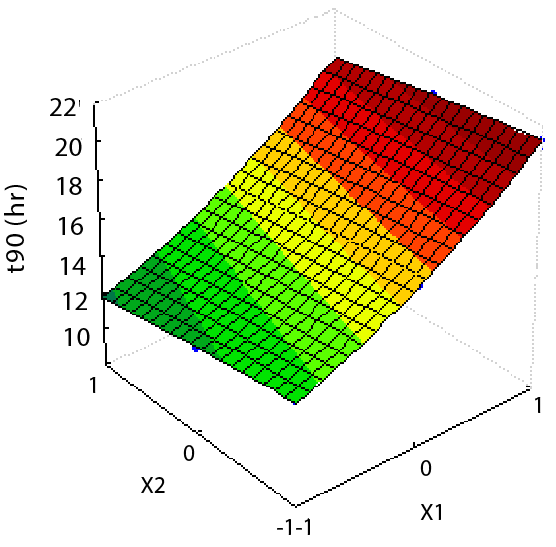
Figure 4: Response surface plot for t90
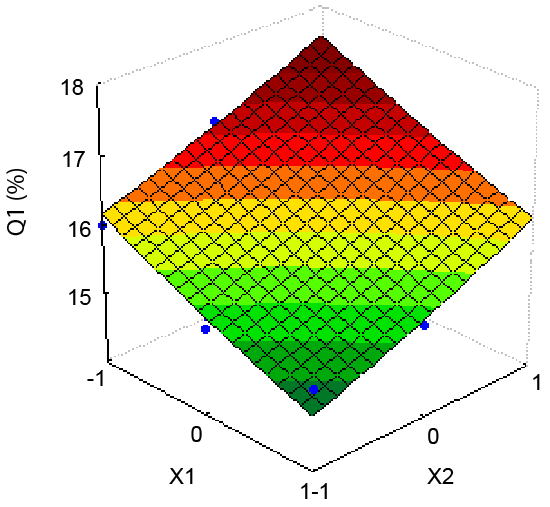
Figure 5: Response surface plot for Q1
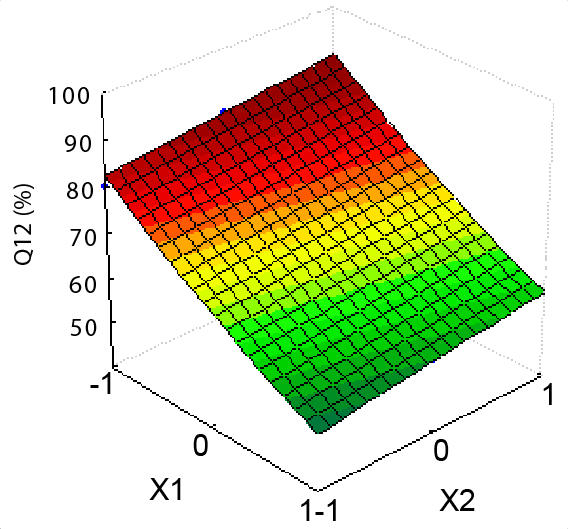
Figure 6: Response surface plot for Q12
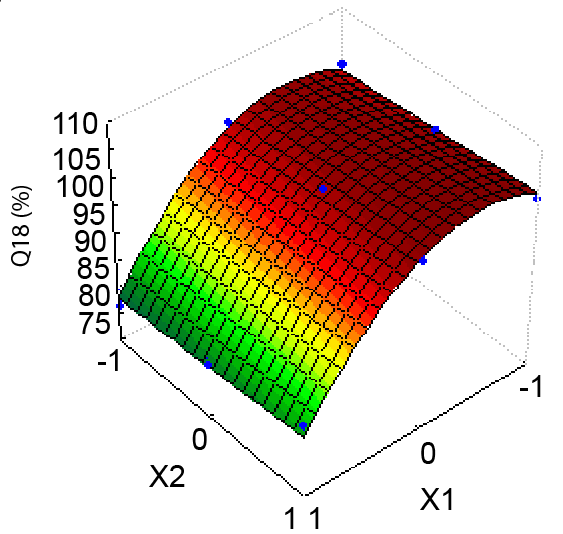
Figure 7: Response surface plot for Q18
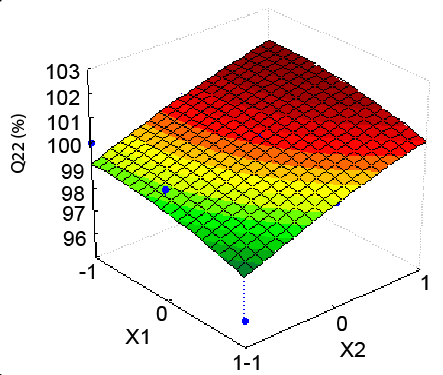
Figure 8: Response surface plot for Q22
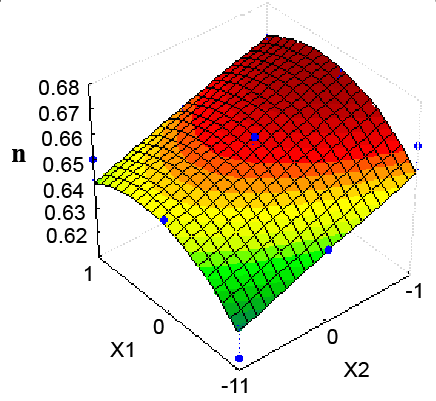
Figure 9: Response surface plot for n
Our data shows that Bilayer tablets of Tolperisone HCl and Diclofenac sodium might be a suitable treatment for acute musculoskeletal spasm or acute low back pain because they allow sequential release of the two drugs.
Authors acknowledge to Themis Medicare, Colorcon Asia, Finar Chemicals and Acme Chemicals for providing gift sample of Tolperisone HCl, Diclofenac sodium, various grades Methocle, Lactose and Aerosil and Magnesium stearate, respectively. The authors are graceful to the principal (Dr. Mukesh R. Patel) of the Shri B. M. Shah Collage of Pharmaceutical Education and Research (Modasa, India) for providing necessary facilities.
The authors report no conflicts of financial interest. The authors alone are responsible for the content and writing of the paper.
Download Provisional PDF Here
Article Type: Research Article
Citation: Jethara SI, Patel MR (2015) Design and Development of Tolperisone Hcl and Diclofenac Sodium Sustained Release Tablet. J Drug Res Dev 1(2): http://dx.doi.org/10.16966/2470-1009.107
Copyright: © 2015 Jethara SI, et al. This is an open-access article distributed under the terms of the Creative Commons Attribution License, which permits unrestricted use, distribution, and reproduction in any medium, provided the original author and source are credited.
Publication history:
All Sci Forschen Journals are Open Access